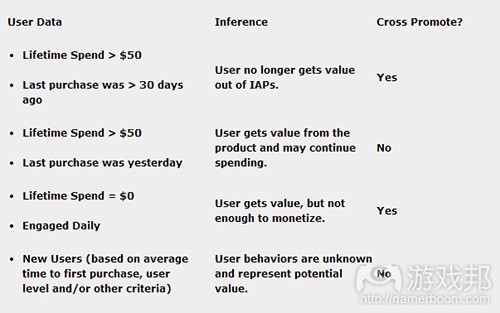有效执行内部交叉推广的6个建议
作者:David Vaghari
资深手机游戏发行商都清楚内部交叉推广是以较低成本(或零成本)推动自己作品集安装并提高用户粘性的有效方式。但是对于那些不熟悉这一方式的人来说,内部交叉推广是推动第一方数字产品以及其它产品流量的一种重要的内部广告活动。多亏其强大的投资回报率,这也是如今产业中利用率最高的一种数字市场营销工具。
但是如果你不能有效使用交叉推广,它便有可能破坏你的性能指标。面向已经沉浸于某一目标产品的用户进行推广有可能吓走这些用户。更糟糕的是如果你将用户推向其它低性能的产品便有可能失去这些本来有价值的用户。
为了避免这些情况你就需要更加谨慎。以下便是帮助你们更有效进行内部交叉推广的6个建议。
划分LTV
用户每天能够花在手机应用上的时间是非常有限的。当你在运行内部交叉推广时你的主要目标应该是确保用户能够花时间在你的游戏上从而让你能够从中获得盈利。所以你可以使用LTV或其它消费行为去瞄准那些可能不愿意继续花时间玩当前游戏的用户。你必须使用不同标准去瞄准不同应用上的用户。例如你的一款应用的平均用户终身消费以及平均消费者的周消费为50美元,那么基于这一信息你便可以遵循以下的建议:
考虑盈利策略
牢记你的每一款应用的应用内部经济以及推动用户在IAP或广告上进行转换的策略。你的一些应用可能拥有一个基于盈利的策略,这便非常适合那些曾接受过广告的用户。你还应该避免在带有复杂虚拟经济(游戏邦注:能够推动用户进行定期应用内部购买)的应用中向消费者推广基于广告的游戏。如果你能将用户带到一个基于非IAP盈利策略(即对于用户来说是一种有效盈利策略)的应用中,你便能够从中获取盈利。
瞄准设备语言而非国家
新人市场营销者在运行本土化活动时经常犯的一个错误便是利用面向目标区域最多人使用的语言所进行本土化的内容。虽然乍看之下这是合情合理的,但事实上每年都有超过10亿人在世界各地旅行,更不用提那个跨越全球的巨大社区群体了。根据我们的经验,不同区域的手机用户和使用当地母语的用户是不成正比的,所以当你在本土化内容时应该注重设备语言而非地理数据。
A/B测试你的创意
如果你想要留给用户更好的印象,你就必须通过多轮分离测试去检测自己的创意。为目标用户划分标题,主体内容,图像/视频和行动纲领。如果你拥有的资源很有限,你便可以选择A/B测试。你可以让创意团队创造另一份编辑内容并突显不同的功能集然后进行对比。像Upsight等手机市场营销套件都能帮助你轻松将更突出的内容呈现在目标用户面前。
不要面向已经拥有应用的用户推广该应用
市场营销者必须避免向已经在设备上安装了应用的用户推广该应用。有两种方法能够帮助你们做到这点:最简单的方法便是和Upsight等市场营销平台合作,他们支持实时拦截功能,即能够检测到设备上现有的第一方应用并阻拦任何相关推广活动。还有一种选择便是面向当前用户创造一份设备ID列表并明确那些不能推广的用户。如果你选择了后面这种方法,你还需要确保定期更新列表以避免一些重叠。
优先考虑类型关联性
如果你能够瞄准那些最有可能关注你的应用的用户,你的内部交叉推广活动便能够取得最佳结果。数据只能帮助我们掌握部分用户信息,如果你能够掌握他们使用过怎样的应用,你将能够获得更多重要信息。如果这些用户正在寻找更多类似的应用,那么你进行交叉推广的机会便会更高,这也是相似游戏类型间的交叉推广更有效的原因。如果你想提高一款全新游戏的流量但又缺少足够时间,你便可以选择交叉推广相似类型的游戏。
(本文为游戏邦/gamerboom.com编译,拒绝任何不保留版权的转发,如需转载请联系:游戏邦)
The 6 Keys To Flawless Internal Cross Promotions
by David Vaghari
Veteran mobile publishers know internal cross promotion can be an effective way of driving installs and engagement across their portfolios at little to no cost. For anyone less familiar, internal cross promotions are essentially in-house ad campaigns designed to drive traffic from one first-party digital product to another. Thanks to their unimpeachable ROI ratio, they’ve remained one of the most highly-utilized digital marketing tools in the industry.
Cross promotions are, however, unique in that they can do serious harm to your performance metrics if handled improperly. Promoting products to users who already engage with the target product is a good way to accelerate churn. Worse still is the potential to cannibalize what would have otherwise been valuable users by pushing them into another, lower-performing product.
Preventing this requires a few special considerations. Below are the 6 keys to a flawlessly executed internal cross promotion.
Segment By LTV
Users have a finite amount of time to spend in mobile applications every day. Your primary objective when running an internal cross promotion is to ensure that your users spend their time in the titles that monetize them most effectively. Use LTV and other spending behaviors to target users that are unlikely to continue spending in their current title. Keep in mind that the criteria used to target these users will be unique to every application. Let’s say for example, you have an app where the average lifetime spend of a user is $50 dollars and the average spender spends once a week. Based on this information alone the following recommendation would be made:
User Data
Inference
Cross Promote?
Lifetime Spend > $50
Last purchase was > 30 days ago
User no longer gets value out of IAPs.
Yes
Lifetime Spend > $50
Last purchase was yesterday
User gets value from the product and may continue spending.
No
Lifetime Spend = $0
Engaged Daily
User gets value, but not enough to monetize.
Yes
New Users (based on average time to first purchase, user level and/or other criteria)
User behaviors are unknown and represent potential value.
No
Consider Monetization Strategy
Keep in mind the existing in-app economy for each of your applications as well as the strategy for enticing users to convert on IAPs or Ads. Some of your applications may have an ad centric monetization strategy, which would be ideal for users that have demonstrated engagement with ads in the past. Avoid promoting ad-focused titles to spenders in applications with complex virtual economies that entice users to make regular in-app purchases. By moving them to an app where the monetization strategy is not focused on IAP, which has been proven to be an effective monetization strategy for this user, you are effectively cannibalizing them.
Target Device Language, Not Country
Novice marketers often make the mistake of running geographically targeted campaigns that leverage content localized to an area’s most widely-spoken language. While it might make sense at first, consider the fact that more than a billion people travel internationally every year, to say nothing of the sizable expat communities living across the globe. In our experience, the percentage of mobile users in geographic regions that don’t match their first language is significant enough that localized creative should target device language, not geographic data, to ensure higher campaign performance.
A/B Test Your Creatives
If you’re going to be delivering thousands of impressions, it’s worth putting your creative through a few rounds of multivariate split testing. Sorting out which headline, body copy, image/video, and call-to-action work best for your target audience will pay dividends indefinitely. If you’re limited on resources, keep in mind that there’s nothing saying A/B tests need to be complex. Just ask your creative team for an alternative edit that highlights a different set of features and put one up against the other for a statistically significant number of impressions. Most mobile marketing suites like Upsight will let you push the winner to all targeted users with a single click.
Don’t Advertise Applications Users Already Have
Given that users can only have one instance of an app on their device at a time, marketers will want to avoid promoting titles that are already installed. There are two ways to do this: The easiest method is to partner with a marketing platform like Upsight that supports real time campaign suppression, which will detect the presence of existing first-party applications on a device and block any campaigns promoting it. The other option is to manually pull a list of device IDs for current users and set up negative targeting. If you choose the latter, make sure to update your list regularly to ensure minimal overlap.
Prioritize Genre Relevance
Internal cross promotion campaigns get the best results when they target the users most likely to pay attention. While data only ever grants us a limited understanding of our users, the most telling bit of information you have is what app they’re already in. Chances are if they’re ready to be targeted for cross-promotion, they’re looking for more of the same, which is why cross promotions between games of a similar genre are most effective. If you’re looking to pump traffic into a new title but are short on time, prioritize cross promoting titles of a similar genre to get things moving fast.(source:gamasutra)









































 闽公网安备35020302001549号
闽公网安备35020302001549号